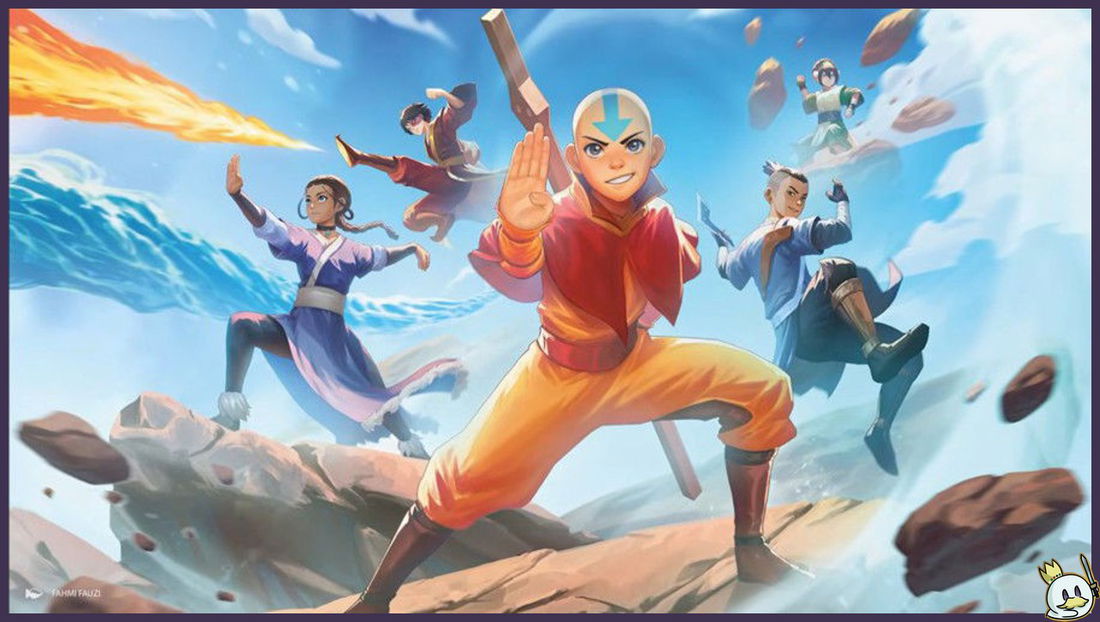With over three decades of existence, the history of Magic: The Gathering as a competitive card game is one of the most fascinating to learn about for TCG enthusiasts. Many of the foundations that permeate many other games were born with Magic, and many of these came not only from design decisions but also from the construction of more innovative decks.
To celebrate this long history, we started a series of articles about the decks that made history in Magic, strategies that changed the way of thinking about the game, building lists, which cards to add and even the way the TCG was designed.
We separated the series into three episodes - one for each decade - and in the third and final episode, we delve into the decks between 2014 and 2024, a period in which Magic went through several stages of power creep that eventually culminated in more bans and more situations that generated controversy as social media grew.
If you want to check out the other articles in the series, access the first part, where we cover decks from 1993 to 2003 and second part
, with the archetypes between 2004 and 2013.
Decks that made History in Magic - 2014 to 2024
2014 - Abzan Midrange
Khans of Tarkir was one of the main power creeps in the past decade, to the point of invalidating almost the entire list from the previous block, Theros, in Standard. Since the release of the first set, the format's decks have been practically dominated by Tarkir cards and mechanics with some minimal support coming from previous sets, and at the center of them, an archetype has left its mark on history: Abzan Midrange.
Known for the famous saying that “a Siege Rhino always pulls another Siege Rhino”, Abzan Midrange became the main archetype in Standard, where it was complemented by versions running Whip of Erebos and competed with Esper Dragons for the title of best deck for a long time, but the combination of Siege Rhino and Courser of Kruphix exceeded expectations and gave Modern 

2015 - Amulet Titan
The history of Amulet Titan begins back in the first Modern Pro Tour in 2011, where the plan involved using Cloudpost and Glimmerpost with Amulet of Vigor and Primeval Titan to play Emrakul, the Aeons’ Torn. Little by little, the archetype began to transform into something else, specifically geared towards the Hive Mind combo with the Future Sight Pact cycle for a combo-kill, but it took until 2015 for the archetype to gain traction and become one of Modern's main competitors - a space it has not left since then despite the power creep storm of the Modern Horizons expansions.
The popularity of Amulet Titan led to the banning of Summer Bloom in 2016, but the archetype remained a viable strategy and gained one tool after another with each set: from Dryad of the Ilysian Grove that allowed for the combo with Valakut, the Molten Pinnacle to Urza’s Saga that allowed for more consistently finding Amulet of Vigor while offering another alternative win condition.
Ten years after its rise in the competitive Metagame, Amulet Titan remains one of the core decks in Modern, making it the most resilient archetype in the history of the format.
2016 - Eldrazi
In the first part of this series, we talked about Black Summer, a time when Necropotence was such a prevalent card that it defined the Metagame between those who played the card and those who played something to combat it. But the terrors of that time do not compare to what became known as Eldrazi Winter.
The story began with the release of Oath of the Gatewatch, which brought Eldrazi creatures with reduced costs, with the “drawback” of having to pay colorless mana to play them, but Modern had two lands that were specifically dedicated to Eldrazi - Eldrazi Temple and Eye of Ugin, both released the first time these interplanar threats appeared in the Magic universe as permanents that cost between seven and fifteen mana to cast.
The first result of this mix came at Pro Tour Oath of the Gatewatch, where Eldrazi made up just 8.2% of the Day 1 metagame, but six copies made it to the Top 8 of the event in perhaps the largest conversion of a deck to the Top 8 in Modern history - the warning sign going off led to a rise from the community, with some asking in advance for an emergency ban.
In the following weeks, the Modern metagame was already dictated by all possible Eldrazi variants: colorless, 



2017 - Death’s Shadow
From draft bulk to format-defining staple. The story of Death’s Shadow begins in 2016 with the birth of a variant of the Zoo decks that used the Worldwake avatar with Street Wraith to increase the pressure against the opponent in an aggressive archetype, but Shadow became the deck it is today with the release of an uncommon in Aether Revolt, in 2017 - Fatal Push.
Fatal Push changed Magic forever. Its interaction with fetch lands and cheap cost in a color that still didn’t have decent one-mana removal changed the entire Modern metagame, put Tarmogoyf in a crisis from which it never recovered, and changed the threshold at which decks could operate in mana efficiency.
During this period, the Modern Metagame was hostile to fair decks like Jund: between Amulet Titan, Tron, and a few other combos, the format was too fast for a strategy to gain added value on every play, and that's how Traverse Shadow came into the hands of Josh Utter-Leyton and changed the way of looking at these games with a super aggressive one-drop with combo-kill potential with Temur Battle Rage that preyed on the decks that traditional Jund had trouble against.
A few weeks later, Jund Shadow became the most popular strategy in Modern, where it was both the best positioned archetype for the Metagame and also the best Fatal Push strategy, since it took full advantage of the new card's mana efficiency. Eventually, Shadow players needed to prepare for the mirror, and that's how Grixis Shadow was born, a more popular variant, more prepared for the Metagame, which became the best deck in the format for many months, even causing a professional player to speak out in a video asking for the banning of Death's Shadow when Claim // Fame was revealed in Hour of Devastation.
Grixis Shadow alone has caused one shift after another as the metagame has tried to adapt: from the rise of Prison decks with Ensnaring Bridge, the rise of Chalice of the Void in many lists to deal with cheap cantrips and Death’s Shadow, the rise of Death & Taxes finally appearing in Modern to counter a strategy that operated in the same way that Delver of Secrets decks did in Legacy, and even the birth of Humans as a strategy designed to punish the main plays of Shadow lists with Reflector Mage and Thalia, Guardian of Thraben.
Each of these steps eventually made it just another deck in the metagame, a testament to how formats can adapt to emerging strategies that become too strong for a while.
2018 - RB Aggro
Red Aggro's trajectory in Magic is, in theory, the most successful in the competitive scene: Mono Red and its branches are and always will be decks that will be present in all formats due to the ease of building them with the ideal mix of cards and abilities.
But staying at the top of the Metagame is always a challenge for them, after all, the more cards enter the format, the more complex it becomes and the more answers the other strategies gain against an archetype whose plan involves pressuring the opponent and winning in the shortest possible sequence of turns.
The Kaladesh-Ixalan season put red Aggro in the spotlight as the best deck in the format throughout its longevity: the mix of Goblin Chainwhirler and Chandra, Torch of Defiance transformed what would be a traditional Aggro into an archetype with an efficient attrition plan that even limited the viability of many creatures and archetypes from even existing in the format.
Among them, RB Aggro, basically a Mono Red with a slight splash of 
2019 - Hogaak
The first Modern Horizons truly expanded the horizons of Modern like no other set had done before. The amount of staples that arrived in the format through it changed the Metagame forever and would set the precedent for what would become the habit whenever another product of this category was released: an artificial rotation caused by the increase in the cards' sheer power level, which did not need to go through Standard and, therefore, could have a significantly higher ceiling.
It is common for some of these MH cards to break formats - believe me, this will not be the only deck around this controversy in this article - and the first to open this history was Hogaak, Arisen Necropolis, whose archetype around it broke Modern in half and created a dominance in the Metagame that had not been seen since Eldrazi Winter.
Hogaak's problem was that it attacked from many different angles and was extremely resilient to hate. To be more precise, the Sideboard of Hogaak lists as the deck improved, was limited exclusively to the objective of dealing with hate and responding to the mirror, not much different from what Affinity did in 2004 when it dominated Standard.
In an attempt to weaken the archetype without having to ban anything from its premium set, Wizards removed Bridge from Below from Modern, a move that some argue made the deck evolve and become better than it already was, to the point where it took five of the eight places at Grand Prix Las Vegas shortly before its fateful ban along with Faithless Looting.
2020 - Uro Piles
2020 was a strange year for Magic, or for humanity and the civilized world as we knew it, so a deck that “made history” that year would be an impossible task - there were cases like Temur Reclamation that reached absurd numbers in Standard, but that was just a consequence of the F.I.R.E. philosophy adopted by the design team starting with War of the Spark, and there is no other archetype that presents an amalgamation of what F.I.R.E. was like other than Modern's Uro Piles.
From Field of the Dead and Mystic Sanctuary to Uro, Titan of Nature’s Wrath and Omnath, Locus of Creation, Wrenn and Six and Teferi, Time Raveler and a mana base that basically allowed you to play cards of any color, Uro Piles is the culmination of everything that F.I.R.E. brought to Magic - and in that list, we don’t even have Yorion, Sky Nomad as a companion - and the way in which the power creep caused by this change in the way of creating cards permanently altered the competitive structure, also culminating in more bans in practically every format, including Modern itself, where Uro, Titan of Nature’s Wrath, Field of the Dead and Mystic Sanctuary were eventually banned.
2021 - Chatterstorm
When Modern Horizons II came out, the metagame of all formats changed forever. If MH1 already brought some impactful staples and controversial cards that were banned, MH2 pushed the power level to the ceiling with cycles like Evoke Elementals or individual pieces like Ragavan, Nimble Pilferer and Murktide Regent, and its impact was also felt in Pauper with the introduction of Chatterstorm and a new cycle of dual artifact lands with Indestructible.
The result in Pauper was felt very early: the format has no way to deal with Storm. You could use Duress, try to play with more cheap interactions, but the combination that Galvanic Relay and Chatterstorm allowed was too efficient, and if a player focused too much on playing against Storm, Affinity would catch up to them easily - As result, the Metagame polarized like never before, and only three archetypes managed to succeed in tournaments: Storm, Affinity and Faeries.
It took Wizards months to solve the problem and Pauper languished for a long time during that period: players entered events with lists running only basic lands as a protest, independent tournament organizers went so far as to create a parallel banned list to keep the format interesting despite the company's inertia until, finally, it removed Chatterstorm and Sojourner's Companion from Pauper in September 2021.
We can't say that the delay and active protests from the Pauper community in what is considered the worst environment the format has ever had didn't bear fruit: at the beginning of the following year, Wizards announced the Pauper Format Panel, a committee specialized in the format dedicated to giving the company suggestions on potential interventions that the format needs and a link between the community's demands and the banned list.
Since then, interventions in Pauper have become more assertive and faster, and even when they do not exist, the PFP communicates through the official Magic channel with a certain periodicity, in addition to making proactive decisions for the good of the format, such as banning Cranial Ram before the release of Modern Horizons 3 - none of this would have happened if Chatterstorm had not broken the format in half.
2022 - Rakdos Midrange
The birth of a more traditional Midrange in Pioneer was due to the sequence of cards that came out between the end of 2021 and throughout 2022: Bloodtithe Harvester, Graveyard Trespasser and especially Fable of the Mirror-Breaker created the foundation that established one of Pioneer's most iconic archetypes and whose position among one of the best decks in the Metagame has been assured ever since, Rakdos Midrange.
Based on Modern's classic Jund, this has become one of the most popular archetypes in the format and one of Pioneer's fun police that help define whether the Metagame is healthy - and also one of the strategies that pose the most risks to it, such as when Murders at Karlov Manor introduced Vein Ripper in 2024, which made the archetype adopt a Vampires core with Sorin, Imperious Bloodlord and break Pioneer in half.
Today, Rakdos Midrange focuses on a plan with Unholy Annex and Mutavault in Rakdos Demons, with powerful insertions that it has received in recent years, but nothing seems to stop it from remaining as one of the top contenders of the Metagame and, therefore, being remembered in the years following its birth as a constant presence in Pioneer.
2023 - Rakdos Evoke
Lord of the Rings brought quite a few changes to Magic's eternal formats with some of its main cards, and the first one that had immediate effects on the Metagame was Orcish Bowmasters, a card that seemed aimed at Legacy where spells like Brainstorm and Preordain are very common. But in Modern, it leveraged one of the most unfair archetypes in the Metagame to the top of the format - Rakdos Evoke.
Focused on the interplay of elementals Grief and Fury with cheap reanimate effects like Not Dead After All and Feign Death, Evoke had a poor matchup against archetypes that had a better topdeck than it - especially Izzet Murktide, which could generate positive value with the top filtering of Dragon’s Rage Channeler or the abundance of cheap cantrips in the list. But with Bowmasters, the matchup turned around and Rakdos became heavily favored, making Evoke the most prevalent deck in Modern that year.
Eventually, Fury was banned from Modern as a way to mitigate its consistency, but Grief remained a strong card in the Metagame and even motivated Legacy players to adopt the same strategy in Reanimator lists, transforming it into a Tempo deck with the famous combo-kill that this archetype has always had by bringing back a seven or more mana bomb with Reanimate.
Grief was only banned from Modern in 2024, along with what was the most controversial card of that year.
2024 - Bant Nadu
Nadu, Winged Wisdom is by far the most controversial card of 2024. Released in Modern Horizons 3, it has an ability that made a non-deterministic combo with Shuko or Outrider en-kor a valid strategy, and like every new Magic deck, players needed to test the viability of the combo only to discover that it was absurdly broken: Nadu was too consistent, the ways to find the key pieces were too diverse, and from the point where players discovered lines where they could just repeat the loop until they reached the desired result with Springheart Nantuko and Endurance, Nadu became almost impossible to counter.
The result was evident: five of the eight places in the Top 8 of Pro Tour Modern Horizons 3 were Bant Nadu decks. The quarterfinals and finals were mirror matches, and the public reaction to watching matches where players didn't interact with each other and that took a long time to execute only created a bad reputation for Modern.
Eventually, Nadu, Winged Wisdom was banned from the format, but the controversy continued when, along with the ban, Wizards released an article with one of the designers of Modern Horizons 3 explaining how the card was created - in it, the author explains that Nadu had other abilities, among them the ability to give Flash to its controller's permanents, and this was viewed with concern by the testing team due to the Commander format, forcing a last-minute change to the card that culminated in its iteration released in the set, which did not undergo proper testing before being delivered.
The article sparked discussions about why a Modern-oriented set should think and design cards for Commander, especially when MH3 had its own wave of Commander preconstructed decks that Nadu could have fit into without destroying Modern's health. And in a cruel twist of irony, Nadu, Winged Wisdom also had to be banned from Commander that same year, for the same reasons that led to his ban in Modern.
Conclusion
That's all for today!
If you have any questions, feel free to leave a comment!
Thanks for reading!














— Comments 0
, Reactions 1
Be the first to comment